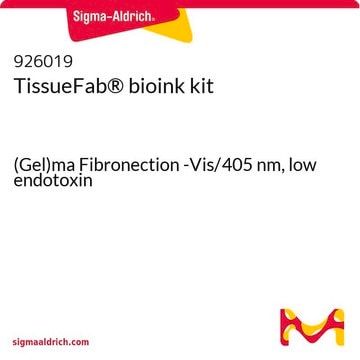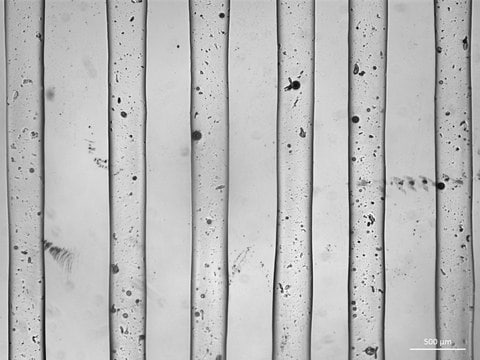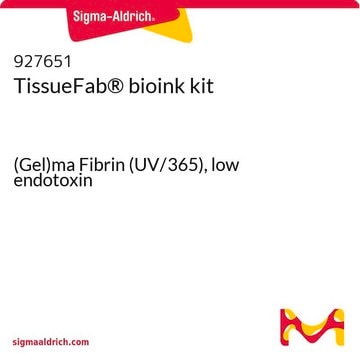927074
TissueFab® bioink kit
(Gel)ma Fibrin (Vis/405), low endotoxin
Sinónimos:
Fibrin, Fibrinogen, GelMA, Gelatin methacrylamide, Gelatin methacrylate, Gelatin methacryloyl, Thrombin
About This Item
Productos recomendados
Quality Level
form
(Solid chunks, fibers or powder)
impurities
<10 CFU/g Bioburden (Fungal)
<10 CFU/g Bioburden (Total Aerobic)
<125 EU/g Endotoxin
color
, Pale white to colorless
application(s)
3D bioprinting
storage temp.
2-8°C
¿Está buscando productos similares? Visita Guía de comparación de productos
Categorías relacionadas
General description
The protocol can be found under "More Documents" at the bottom of the page.
TissueFab® bioink kit- (Gel)ma Fibrin (Vis/405), low endotoxin contains:
2- 500 mg lyophilized ink components
1- lyophilized thrombin powder
1- 10 ml HEPES buffer.
Gelatin methacryloyl (GelMA) is a polymerizable hydrogel material derived from natural extracellular matrix (ECM) components. Due to its low cost, abundance, and retention of natural cell binding motifs, gelatin has become a highly sought material for tissue engineering applications. Fibrinogen is a soluble glycoprotein produced by liver. It can be emzymatically polymerized to fibrin monomers by thrombin and then to fibrin based blood clot during blood coagulation. With multi cell binding sites, such as RGD (Arg-Gly-Asp), fibrin plays an important role in celluer-matrix interaction, can promote cell adhesion, proliferation and migration.
Application
Features and Benefits
Low Endotoxin, low bioburden: Endotoxins have been demonstrated negatively impact cellular growth, morphology, differentiation, inflammation and protein expression. Bioburden is defined as the number of contaminated organisms found in a given amount of material. We test each lot for endotoxins as well as total bioburden (aerobic and fungal) to minimize unwanted interactions. For more information: https://www.sigmaaldrich.com/US/en/technical-documents/technical-article/microbiological-testing/pyrogen-testing/what-is-endotoxin
Legal Information
related product
signalword
Danger
hcodes
Hazard Classifications
Eye Irrit. 2 - Resp. Sens. 1 - Skin Irrit. 2 - STOT SE 3
target_organs
Respiratory system
Storage Class
10 - Combustible liquids
Certificados de análisis (COA)
Busque Certificados de análisis (COA) introduciendo el número de lote del producto. Los números de lote se encuentran en la etiqueta del producto después de las palabras «Lot» o «Batch»
¿Ya tiene este producto?
Encuentre la documentación para los productos que ha comprado recientemente en la Biblioteca de documentos.
Nuestro equipo de científicos tiene experiencia en todas las áreas de investigación: Ciencias de la vida, Ciencia de los materiales, Síntesis química, Cromatografía, Analítica y muchas otras.
Póngase en contacto con el Servicio técnico










